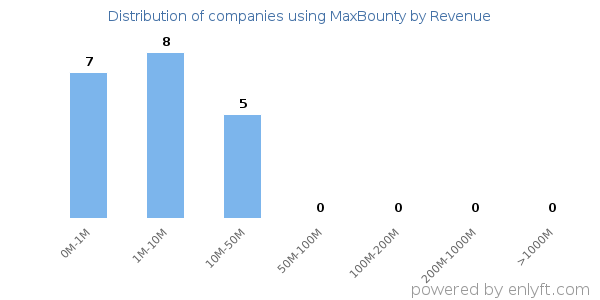Companies using MaxBounty
We have data on 44 companies that use MaxBounty. The companies using MaxBounty are most often found in United States and in the Retail industry. MaxBounty is most often used by companies with 1-10 employees and 0M-1M dollars in revenue. Our data for MaxBounty usage goes back as far as 7 years and 6 months.
If you’re interested in the companies that use MaxBounty, you may want to check out Advertising.com and SpotXchange as well.
Who uses MaxBounty?
| Company | Noobie Inc. |
| Website | noobie.com |
| Country | United States |
| Revenue | 1M-10M |
| Company Size | 1-10 |
| Company | VIP Real Estate & Marketing Solutions |
| Website | aislee.com |
| Country | United States |
| Revenue | 0M-1M |
| Company Size | 1-10 |
| Company | Internet Archive |
| Website | archive.org |
| Country | United States |
| Revenue | 10M-50M |
| Company Size | 500-1000 |
| Company | PUMPKINS FREEBIES |
| Website | pumpkinsfreebies.com |
| Country | United States |
| Revenue | 1M-10M |
| Company Size | 10-50 |
| Company | FitnessRebates.com |
| Website | fitnessrebates.com |
| Country | United States |
| Revenue | |
| Company Size | 1-10 |
| Company | Website | Country | Revenue | Company Size |
|---|---|---|---|---|
| Noobie Inc. | noobie.com | United States | 1M-10M | 1-10 |
| VIP Real Estate & Marketing Solutions | aislee.com | United States | 0M-1M | 1-10 |
| Internet Archive | archive.org | United States | 10M-50M | 500-1000 |
| PUMPKINS FREEBIES | pumpkinsfreebies.com | United States | 1M-10M | 10-50 |
| FitnessRebates.com | fitnessrebates.com | United States | 1-10 |
Target MaxBounty customers to accomplish your sales and marketing goals.
MaxBounty Market Share and Competitors in Ad Networks
We use the best indexing techniques combined with advanced data science to monitor the market share of over 15,000 technology products, including Ad Networks. By scanning billions of public documents, we are able to collect deep insights on every company, with over 100 data fields per company at an average. In the Ad Networks category, MaxBounty has a market share of about 0.1%. Other major and competing products in this category include:
Ad Networks
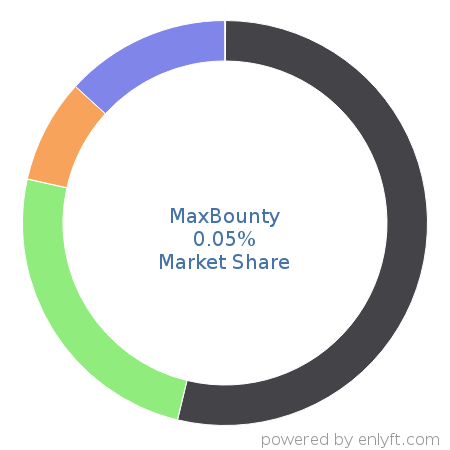

What is MaxBounty?
MaxBounty is a CPA (cost per action) affiliate marketing network which provides affiliate marketers the opportunity to become affiliates for different companies (vendors) and earn extra money for every website visitor they bring to these companies.
Top Industries that use MaxBounty
Looking at MaxBounty customers by industry, we find that Retail (10%), Computer Software (8%), Entertainment (5%) and Internet (5%) are the largest segments.
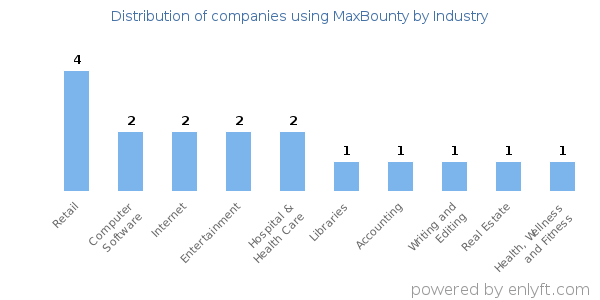
Top Countries that use MaxBounty
67% of MaxBounty customers are in United States, 13% are in Australia and 13% are in Netherlands.
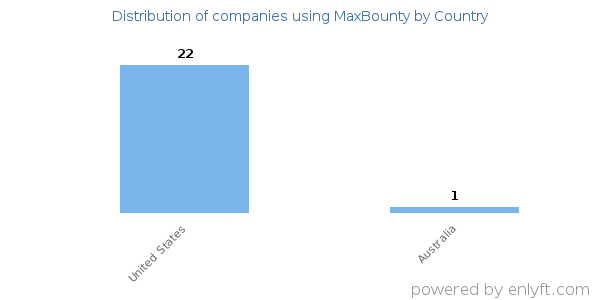
Distribution of companies that use MaxBounty based on company size (Employees)
Of all the customers that are using MaxBounty, a majority (71%) are small (<50 employees), 0% are large (>1000 employees) and 20% are medium-sized.
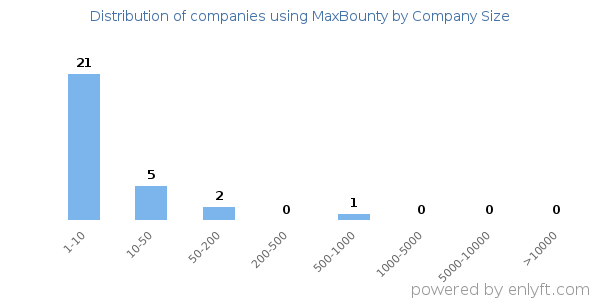
Distribution of companies that use MaxBounty based on company size (Revenue)
Of all the customers that are using MaxBounty, a majority (93%) are small (<$50M), 0% are large (>$1000M) and 0% are medium-sized.
